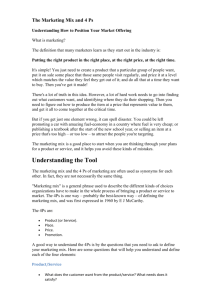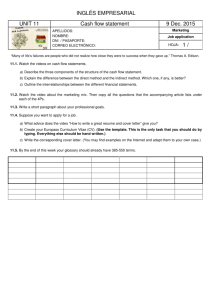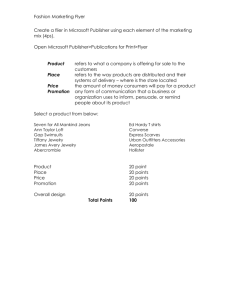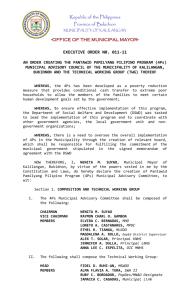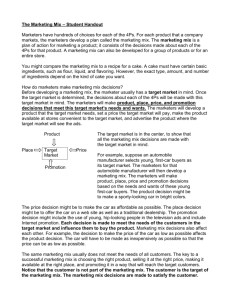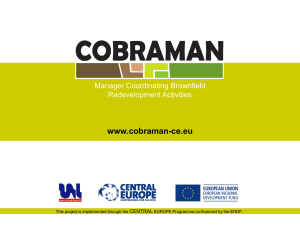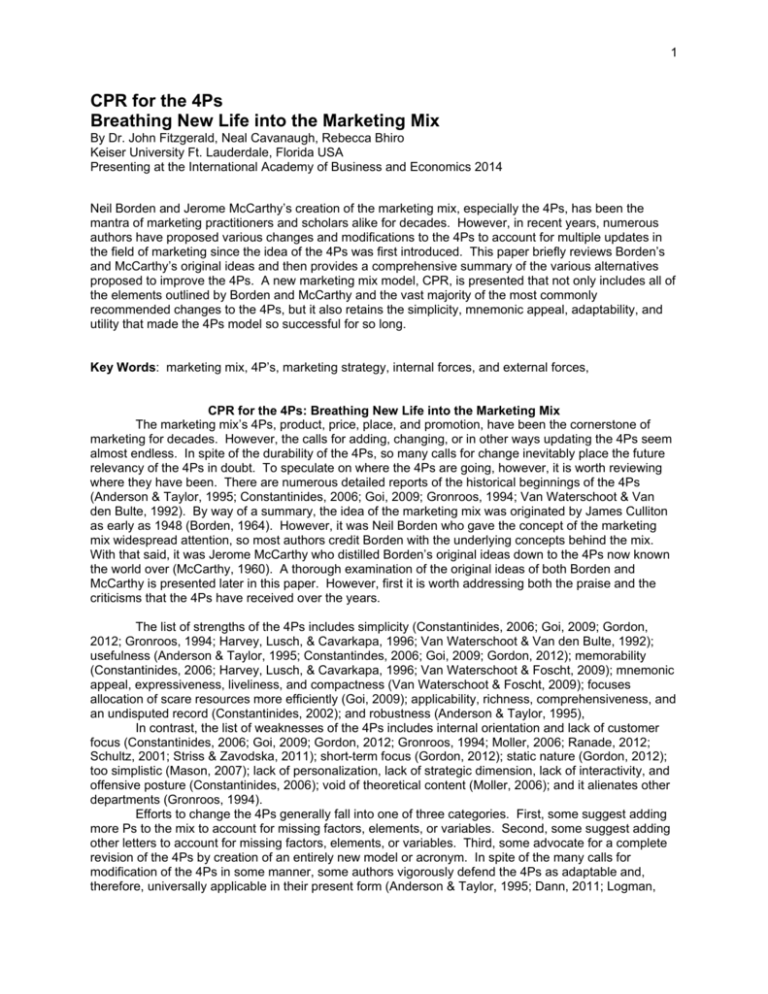
1
CPR for the 4Ps
Breathing New Life into the Marketing Mix
By Dr. John Fitzgerald, Neal Cavanaugh, Rebecca Bhiro
Keiser University Ft. Lauderdale, Florida USA
Presenting at the International Academy of Business and Economics 2014
Neil Borden and Jerome McCarthy’s creation of the marketing mix, especially the 4Ps, has been the
mantra of marketing practitioners and scholars alike for decades. However, in recent years, numerous
authors have proposed various changes and modifications to the 4Ps to account for multiple updates in
the field of marketing since the idea of the 4Ps was first introduced. This paper briefly reviews Borden’s
and McCarthy’s original ideas and then provides a comprehensive summary of the various alternatives
proposed to improve the 4Ps. A new marketing mix model, CPR, is presented that not only includes all of
the elements outlined by Borden and McCarthy and the vast majority of the most commonly
recommended changes to the 4Ps, but it also retains the simplicity, mnemonic appeal, adaptability, and
utility that made the 4Ps model so successful for so long.
Key Words: marketing mix, 4P’s, marketing strategy, internal forces, and external forces,
CPR for the 4Ps: Breathing New Life into the Marketing Mix
The marketing mix’s 4Ps, product, price, place, and promotion, have been the cornerstone of
marketing for decades. However, the calls for adding, changing, or in other ways updating the 4Ps seem
almost endless. In spite of the durability of the 4Ps, so many calls for change inevitably place the future
relevancy of the 4Ps in doubt. To speculate on where the 4Ps are going, however, it is worth reviewing
where they have been. There are numerous detailed reports of the historical beginnings of the 4Ps
(Anderson & Taylor, 1995; Constantinides, 2006; Goi, 2009; Gronroos, 1994; Van Waterschoot & Van
den Bulte, 1992). By way of a summary, the idea of the marketing mix was originated by James Culliton
as early as 1948 (Borden, 1964). However, it was Neil Borden who gave the concept of the marketing
mix widespread attention, so most authors credit Borden with the underlying concepts behind the mix.
With that said, it was Jerome McCarthy who distilled Borden’s original ideas down to the 4Ps now known
the world over (McCarthy, 1960). A thorough examination of the original ideas of both Borden and
McCarthy is presented later in this paper. However, first it is worth addressing both the praise and the
criticisms that the 4Ps have received over the years.
The list of strengths of the 4Ps includes simplicity (Constantinides, 2006; Goi, 2009; Gordon,
2012; Gronroos, 1994; Harvey, Lusch, & Cavarkapa, 1996; Van Waterschoot & Van den Bulte, 1992);
usefulness (Anderson & Taylor, 1995; Constantindes, 2006; Goi, 2009; Gordon, 2012); memorability
(Constantinides, 2006; Harvey, Lusch, & Cavarkapa, 1996; Van Waterschoot & Foscht, 2009); mnemonic
appeal, expressiveness, liveliness, and compactness (Van Waterschoot & Foscht, 2009); focuses
allocation of scare resources more efficiently (Goi, 2009); applicability, richness, comprehensiveness, and
an undisputed record (Constantinides, 2002); and robustness (Anderson & Taylor, 1995),
In contrast, the list of weaknesses of the 4Ps includes internal orientation and lack of customer
focus (Constantinides, 2006; Goi, 2009; Gordon, 2012; Gronroos, 1994; Moller, 2006; Ranade, 2012;
Schultz, 2001; Striss & Zavodska, 2011); short-term focus (Gordon, 2012); static nature (Gordon, 2012);
too simplistic (Mason, 2007); lack of personalization, lack of strategic dimension, lack of interactivity, and
offensive posture (Constantinides, 2006); void of theoretical content (Moller, 2006); and it alienates other
departments (Gronroos, 1994).
Efforts to change the 4Ps generally fall into one of three categories. First, some suggest adding
more Ps to the mix to account for missing factors, elements, or variables. Second, some suggest adding
other letters to account for missing factors, elements, or variables. Third, some advocate for a complete
revision of the 4Ps by creation of an entirely new model or acronym. In spite of the many calls for
modification of the 4Ps in some manner, some authors vigorously defend the 4Ps as adaptable and,
therefore, universally applicable in their present form (Anderson & Taylor, 1995; Dann, 2011; Logman,
CPR FOR THE 4PS
2
1997; Mason, 2007; Moller, 2006; Van Waterschoot & Foscht, 2009). The durability of the 4Ps displayed
over the past half-century offers strong support for their continued relevance.
Even though the 4Ps remain largely unscathed, there have been significant changes in the field
of marketing, as well as in the broader field of business. One of the most significant changes has been
the invention of the internet since Borden and McCarthy wrote about the marketing mix. Many authors
have described how the web has changed both consumer buying behavior and marketing methods (Azadi
& Rahimzadeh, 2012; Claffey, 2006; Constantinides, 2002; Mosley-Matchett, 1997; Rousey &
Morganosky, 1996; Wang, Head, & Archer, 2000). Other authors have pointed out how business patterns
have changed from mass marketing and a goods economy to one of personal marketing and a services
economy (Afridi, 2009; English, 2000; Goldsmith, 1999; Gronroos, 1994; Lauterborn, 1990; Logman,
1997; Melewar & Saunders, 2000; Pluta-Olearnik, 2011; Wang et al., 2000; Yelkur, 2000). Still other
authors have argued that the advent of various marketing sub-specialties, such as services marketing,
relationship marketing, B2B marketing, non-profit marketing, cause marketing, social marketing, societal
marketing, and sustainability marketing, all demand a more tailored approach (Anderson & Taylor, 1995;
Healy, Hastings, Brown, & Gardiner, 2001; Gordon, 2012; Gummesson, 1997; Webster, 1992).
This paper was written to answer the following question: Is it necessary, or even possible, to
update the 4Ps model in such a way that would satisfy both the defenders and the attackers of the mix
without sacrificing any of its utility? To answer that question, this paper has three main sections. First, a
review of Bordon’s and McCarthy’s original ideas is presented as both a refresher and as a framework of
analysis for the various criticisms and proposed changes to the 4Ps. Then, in section two, an exhaustive
compilation of the multiple recommendations for altering the 4Ps is presented as a method of identifying
similarities, differences, and patterns among the various proposals. From the results of sections one and
two, a third section is presented which offers a new marketing mix model that not only contains all of the
original elements from Borden’s and McCarthy’s writings, but that also addresses the most commonly
cited missing elements proposed by various authors to account for the new marketing sub-specialties and
the new dynamics of marketing in this millennium. However, perhaps most importantly, the new mix,
CPR, retains the simplicity, mnemonic appeal, adaptability, and usefulness that made the 4Ps so popular
for so many decades. By way of an introduction, CPR has the potential to breathe new life into the
marketing mix.
McCarthy and Borden: A Refresher
While Borden (1964) is credited with popularizing the idea of the marketing mix, it was McCarthy
(1960) who distilled the ideas down to the 4Ps that have become the basis for marketing, so this
discussion begins with him. Figure 1 depicts the concept of the 4Ps marketing mix as first described by
McCarthy in his 1960 book.
Figure 1. McCarthy’s original concept of the 4Ps marketing mix.
Cultural & Social Environment
Political & Legal
Environment
Product
Place
Resources &
Objectives of
The Firm
C
Price
Economic
Environment
Promotion
Existing Business
Situation
CPR FOR THE 4PS
3
As mentioned in the introduction above, the most common criticisms of the 4Ps idea is that it fails
to account for the customer and that it is internally focused. However, as shown, McCarthy depicted the
4Ps in a circle surrounding the customer at the center. In other words, McCarthy knew back in 1960 what
is widely trumpeted today that everything revolves around the customer! It appears many people have
either forgotten or overlooked that component of McCarthy’s model. Furthermore, the outer circle
surrounding the 4Ps includes various external forces that shape or influence creation of the optimum 4Ps
marketing mix. In other words, McCarthy also knew back in 1960 what is widely known today that an
optimum marketing mix must consider various external forces. Once again, it appears many people are
unaware of that aspect of McCarthy’s model.
As a result, it would be reasonable to defend the 4Ps concept as is, as some authors continue to
do, since if it was known and applied in the spirit and intent when first penned by McCarthy, the main
criticisms become invalid. That is likely one reason why the 4Ps have lasted so long. In spite of that,
however, simply defending the 4Ps fails to address the technological changes to marketing since 1960
(e.g., the internet) and the creation of various marketing sub-specialties since 1960 (e.g., services
marketing, relationship marketing, non-profit marketing, etc.). More importantly, defending the status quo
of the original 4Ps continues to ignore the apparent reality that most people do not associate the
customer-centered and externally-influenced nature of the marketing mix model espoused by McCarthy
with the 4Ps that most marketers know by heart. That is a deficiency that can be remedied.
Turning now to Borden (1960), Table 1 lists his original ideas regarding both the marketing mix
and the external forces. As shown, he had 12 elements in the marketing mix and four external forces that
must be considered.
Table 1: Borden’s original marketing mix concept.
12 Marketing Mix Elements
4 External Behavioral Forces
Product
Consumers’ Buying Behavior
Pricing
The Trade’s Behavior
Branding
Competitor’s Position and Behavior
Channels of Distribution
Governmental Behavior
Personal Selling
Advertising
Promotions
Packaging
Display
Servicing
Physical Handling
Fact Finding and Analysis
With respect to the 12 elements, he addressed product, price, distribution (which McCarthy later
called place), and promotion, so those elements transfer nicely to McCarthy’s 4Ps. However, Borden also
listed branding, personal selling, advertising, packaging, display, servicing, physical handling, and fact
finding and analysis. McCarthy’s book has a chapter on branding and packaging, which are really
included in his promotion P and product P respectively. He also has chapters on both personal selling
and advertising (he calls advertising mass selling to distinguish it from personal selling), which are both
part of his promotion P. He does not mention display, but most people consider that also part of the
promotion P. He also has a chapter on physical distribution, which is the same as Borden’s physical
handling so it is included in the place P.
Therefore, the only elements from Borden that are missing are servicing and fact finding and
analysis. Servicing is confusing because there are two aspects to service as defined by the American
Marketing Association (AMA-2013). One relates to after the sale servicing of the product, which is
addressed very briefly by McCarthy and may be considered part of his product P. The other definition is
service as a product, as opposed to goods as a product. Once again, McCarthy only very briefly
addresses services as a product. That is understandable because in 1960 the U.S. had a goods
economy, not a service economy as it has now. However, that is also a legitimate criticism of his 4Ps mix
because it was designed for goods, not services.
Borden’s other element of fact finding and analysis is also not covered by McCarthy’s 4Ps.
Therefore, that is also a legitimate criticism of the McCarthy model since research is vital to any good
CPR FOR THE 4PS
4
marketing plan. In fairness, McCarthy has a chapter on gathering market information and a chapter on
forecasting market opportunities, but since it is not explicitly part of either the 4Ps or the 5 external forces,
it is a definite flaw in his model.
Turning now to Borden’s four external forces, McCarthy has a chapter on uncontrollable variables
that addresses most of Borden’s forces. Additionally, as mentioned above, his model includes a circle
around the 4Ps that accounts for external forces, both controllable and uncontrollable. Specifically,
Borden’s discussion of trade behavior and competitor’s position and behavior are part of McCarthy’s
discussion of existing business situation. Another force according to Borden is consumer buying
behavior. McCarthy has three chapters discussing consumer buying behavior and consumer is at the
center of his 4Ps model, so one might safely conclude that it is part of the model. The final force from
Borden is governmental behavior. Once again, McCarthy has a chapter on the influence of legislation
and one of the five forces in his model is political and legal environment, so that force is covered. As a
result, all four of Borden’s external forces are covered by McCarthy. In fact, McCarthy has three other
external forces in his model that Borden did not directly address.
The first is cultural and social environment. One might argue, therefore, that the model accounts
for international marketing differences and also accounts for social marketing, cause marketing,
sustainability marketing, societal marketing, nonprofit marketing, and public sector marketing. However,
that does not stop those sub-areas of marketing from calling for changes in the 4Ps to account for those
differences.
The next force that is part of McCarthy’s model is resources and objectives of the firm. Some
authors claim the 4Ps are tactical or operational in nature and so they fail to account for the strategic
considerations of the firm. However, if people actually knew that McCarthy’s model includes those
elements as forces that shape the 4Ps, then those arguments would be moot. In any event, the final
force, according to McCarthy, is economic environment. Once again, that partially addresses Borden’s
force of trade behavior and partially addresses criticisms regarding the model not being strategic in
nature.
Before summarizing this section, it is worth briefly addressing another criticism of the 4Ps. Some
claim it is consumer marketing (which contradicts those that claim it fails to focus on the customer!) and
not retail marketing, industrial marketing, or business to business (B2B) marketing. McCarthy has a
chapter on marketing to businesses rather than consumers. However, admittedly, the model does not
specifically mention B2B marketing so some have called for modifications accordingly.
In summary, there are flaws in McCarthy’s model. However, the biggest problem is that only a
small portion of McCarthy’s model regarding the 4Ps is well known. The other elements of the model
have been forgotten. That has led to criticism of the 4Ps and calls to either add other Ps or other letters
that in many case are actually part of the full model, if it was better known. As a result, the best way to
address all of the criticisms, valid or not, is to create a model that addresses the alleged deficiencies.
Summary of Proposed Changes to the 4Ps
Numerous authors have proposed changes to the 4ps to account for the real or imagined
deficiencies. This section builds on the work done by Constantinides, who in 2006, listed various
suggested modifications in summary format. The tables below are based on his tables, but they include
other ideas he excluded or that have been proposed since 2006. The intent of such a summary is to
identify patterns or trends.
All of the various ideas regarding more Ps or other letters are lumped together below under the
headings of consumer marketing (which is a catch-all category that includes classic goods marketing),
services marketing, relationship marketing, B2B marketing (which includes industrial marketing and retail
marketing), online marketing (which includes e-commerce marketing, mobile marketing, and web
marketing), and other marketing (which includes non-profit marketing, social marketing, societal
marketing, cause marketing, public sector marketing, and sustainability marketing).
Table 2: Consumer Marketing
Source
Proposal
CPR FOR THE 4PS
Mason (1958)
Bucklin (1963)
Trout (1969)
Ohmae (1982)
Kotler (1984)
Traynor (1985)
Wind (1985)
Johnson (1986)
Kotler (1986)
Tellis (1986)
Zeithaml (1988)
Berry (1990)
Robins (1991)
Doyle (1994)
Vignalli & Davies (1994)
5
Add:
Packaging
Proposed a new retail strategy regarding consumer
goods, but no additions or changes to the 4Ps.
Add:
Positioning
Add:
Customers
Competitors
Corporation
Mix should include customers, environment, and
competition. Specifically, add:
Politics
Public.
Add a fifth P to account for Borden’s missing fact
finding and analysis (i.e., research) element:
Probe
Add:
Positioning
Portfolio of Products
Portfolio of Countries
Political Considerations
Public Relations
Program
Add:
Purpose
Probe
Perceive
Perform
Predict
Plan
People
Professional
Add:
Power
Public Relations
Proposed new pricing strategies, but no additions or
changes to the 4Ps.
Proposed new strategies for understanding consumer
buying behavior, but no additions or changes to the
4Ps.
Add:
Service
Customer Sensitivity
Customer Convenience
Add:
Customers
Competitors
Company
Capabilities
Add:
Services
Staff
Proposed a MIXMAP technique to enhance the mix,
but no actual additions or changes to the 4Ps.
CPR FOR THE 4PS
Bennett (1997)
Yudelson (1999)
Schultz (2001)
Dev & Schultz (2005)
Marcu & Gherman (2010)
Striss & Zavodska (2011)
Table 3: Services Marketing
Source
Booms & Bitner (1981)
Cowell (1984)
Vignalli (2001)
Bruner (1989)
Ruston & Carson (1989)
Fryar (1991)
Huevel (1993)
Doyle (1994)
Kotler & Keller (2006)
Hill (2014)
6
Proposed the 5Vs that relate to the customer (Value,
Viability, Variety, Volume, and Virtue), but no actual
additions or changes to the 4Ps.
Replace with new 4Ps:
Product: Performance
Price: Penalty
Promotion: Perceptions
Place: Process
Proposed that the mix should consider the triad of
marketer, employee, and customer, but no actual
additions or changes to the 4Ps.
Replace with SIVA:
Product: Solution
Promotion: Information
Price: Value
Place: Access
Proposed new promotion strategies based on product
life cycle stages, but no additions or changes to the
4Ps.
Considered adding: Process, People, Physical
Evidence, Physical Environment, Position, and
Partners.
Also considered adding: Relevance, Returns,
Relationships, Response, and Retrenchment.
Also evaluated: Consumer or Customer, Company,
Cost, Competition, Channel, Capability, Context,
Convenience, and Communication.
However, they finally just proposed replacing the 4Ps
with 4Cs:
Product: Customer
Price: Cost
Place: Convenience
Promotion: Communication
Proposal
Add:
Participants
Physical Evidence
Process
Adopted Booms & Bitner’s 7Ps exactly as they used
them.
Replace with 4Cs:
Product: Concept
Place: Channels
Price: Costs
Promotion: Communication
Acknowledged that services marketing is unique, but
proposed no additions or changes to the 4Ps.
Add:
Personnel
Kept Product & Price
Replace:
Promotion: Communication
Place: Distribution
CPR FOR THE 4PS
Goldsmith (1999)
Melewar & Saunders (2000)
English (2000)
Grove, Fisk, & John (2000)
Beckwith (2001)
Afridi (2009)
Pluta-Olearnik (2011)
Table 4. Relationship Marketing
Source
Lauterborn (1990)
Rozenberg & Czepiel (1992)
Gronroos (1994)
Webster (1992)
Gummesson (1997)
Patterson & Ward (2000)
7
Adopted Booms & Bitner’s 7Ps, but called them
Personnel, Physical Assets, and Procedures.
Then added:
Personalization
Adopted Booms & Bitner’s 7Ps exactly as they used
them, but then added:
Publications
Replace or augment with 4Rs:
Relevance
Response
Relationships
Results
Add:
Actors
Audience
Setting
Performance
Replace and/or augment with:
Price
Brand
Packaging
Relationships
Considered: Paradox, Perspective, Paradigm,
Persuasion, Passion, Planning, Purpose, Problem,
Positioning, Performance, Portal, Pathways, and
Payments.
However, he finally adopted Booms & Bitner’s 7Ps,
but called them People, Physical Evidence, and
Process.
Used 5Is to characterize the nature of services
(Intangibility, Inseparability, Inconsistency, Inventory,
and Inability to own), but proposed no additions or
changes to the 4Ps.
Proposal
Replace with 4Cs:
Product: Consumer
Price: Cost
Place: Convenience
Promotion: Communication
Acknowledged that relationship (and retention)
marketing is unique, but proposed no additions or
changes to the 4Ps
Add:
People
Process
Organizations
He discussed 30Rs, but proposed no additions or
changes to the 4Ps.
Add:
Communication
Customization
Collaboration
Clairvoyance
CPR FOR THE 4PS
Healy et al. (2001)
8
They argued that the mix must consider the trilogy of
relationships, neo-relationships, and networks, but
proposed no additions or changes to the 4Ps.
Table 5. B2B Marketing
Source
Webster & Wind (1972)
Van der Ster(1993)
Boekema, Van Bueren, Lobstein, Oosterhuis, &
Schweitzer (1995)
Rousey & Morganosky (1996)
Turnbull, Ford, & Cunningham (1996)
Anderson & Narus (1999)
Kotler (2003)
Davis & Brush (1997)
Mulhern (1997)
Parasuraman (1998)
Wang et al. (2000)
Note: This article also applies to Relationship
Marketing and Online Marketing, but it is included
here.
Ettenson, Conrado, & Knowles (2013)
Table 6. Online Marketing
Source
Peattie (1997)
Alderidge, Forcht, & Pierson (1997)
O’Connor & Galvin (1997)
Bhatt & Emdad (2001)
Allen & Fjermestad (2001)
Mosley-Matchett (1997)
Proposal
Proposed new strategies for understanding
organizational buying, but no additions or changes
to the 4Ps.
Acknowledged that retail marketing is unique and
that the logistics and commercial mixes must also
be unique.
Kept Price, Place, and Promotion, but dropped
Product and added:
Assortment
Shop Presentation
Personnel
Adopted Lauterborn’s 4Cs as described under
Relationship Marketing above, although they use
Customer instead of Consumer to reflect the
difference between consumer and B2B marketing.
These articles have more to do with how to apply
the marketing mix in retail or industrial marketing
situations rather than the mix itself.
The authors argue that the 4Ps are not suitable for
industrial marketing and they present 13 strategic
elements to consider, but proposed no additions or
changes to the 4Ps.
Acknowledged that retail marketing is unique, but
proposed no additions or changes to the 4Ps
He says marketing must be personalized with
emphasis on customer service, teamwork, quality,
and excellence, but proposed no additions or
changes to the 4Ps.
He says any marketing mix for relationship, retail,
and web marketing must consider:
Database
Interaction
Network
Replace with SAVE:
Product: Solution
Place: Access
Price: Value
Promotion: Education
Proposal
These articles are about how to apply the 4Ps in ecommerce marketing, but proposed no additions or
changes to the 4Ps.
Proposed using 5Ws as factors to consider when using
web marketing (Who, What, When, Where, and Why),
but proposed no additions or changes to the 4Ps.
CPR FOR THE 4PS
Evans & King (1999)
Chaffey, Mayer, Johnston, & Ellis-Chadwick
(2000)
Lawrence, Corbitt, Fisher, Lawrence, &
Tidwell (2000)
Kambil & Nunes (2000)
Constantinides (2002)
Claffey (2006)
Azadi & Rahimzadeh (2012)
Table 7. Other Marketing
Source
LeDoux (1991)
(sustainability marketing)
Belz (2006)
(sustainability marketing)
Gordon (2012)
(social marketing)
9
This article is more about web site management (e.g.,
planning, access, design, and promotion), not really
about the marketing mix.
They described eight factors that influence web
marketing (potential audience, integration, marketing
support, brand migration, strategic partnerships,
organizational structure, and budget), and then
presented 6Cs that describe the characteristics of a
good web site (capture, content, community,
commerce, customer, and credibility), but proposed no
additions or changes to the 4Ps.
Considered new 5Ps to describe the nature of web
marketing (Paradox, Perspective, Paradigm,
Persuasion, and Passion). Then he suggested adding
2Ps to the current 4Ps:
People
Packaging
Replace or augment with:
Community building
Convenience
Connectivity
Original Event Programming
Replace or augment with 4Ss:
Scope: Strategy, analysis, customers, objectives
Site: Web site experience
Synergy: Integration with other departments
System: Technology administration
Described the five attributes of ICT to web marketing
(pervasive communications, mobility, ubiquity, context,
and personalization) to provide context on how the 4Ps
should be modified accordingly in web marketing, but
proposed no additions or changes to the 4Ps.
They combined the 4Ps with Porter’s (1979) five
competitive forces (threat of new entrants, rivalry
among firms, threat of substitute products, bargaining
power of suppliers, and bargaining power of
customers) to make the application of the 4Ps more
effective in online marketing, but proposed no additions
or changes to the 4Ps.
Proposal
Add:
Preservation
Proposed new sustainability marketing concepts, but
no additions or changes to the 4Ps.
Replace or augment with:
Consumer
Cost
Channels/Strategies
Circumstances
Process
Organization/Competition
CPR FOR THE 4PS
10
There are several observations and conclusions that can be reached regarding the tables above.
First, as well-intentioned as they may be, proposals to completely replace the 4Ps with other letters or
even other acronyms such as SAVE (Ettenson et al., 2013), have not met with success. Presumably, that
may be because they have either failed to address the most commonly cited deficiencies or because they
are too narrowly focused, and so have not garnered enough widespread support from marketing
practitioners or scholars in the various sub-specialties. Second, efforts to explain how the 4Ps can be
modified to specific circumstances have successfully contributed to the continued use of the 4Ps in their
present form. However, doing so has become a work-around that ignores the legitimate flaws that so
many other authors have identified. Third, the addition of other P words, C words, or R words, in that
order, are the most commonly proposed modifications to the 4Ps. Therefore, proposals to either more
effectively apply the 4Ps or to change the 4Ps through the use of words beginning with other letters, such
as I, S, V, and W, as intriguing as they may be, do not enjoy enough support to ever replace or perhaps
even augment the 4Ps. As a result, the following section more closely examines the proposals to add P,
C, and R words to the marketing mix.
Development of the CPR Marketing Mix Model
In aggregate, the most commonly cited additional P words are people/participants (5), positioning
(4), public relations (3), process/procedures (3), physical evidence/environment/assets (3), politics (2),
purpose (2), probe (2), performance (2), planning (2), packaging (2), personnel (2), partner (1), portfolio
(2), program (1), perceive (1), predict (1), professional (1), power (1), personalization (1), publications (1),
paradox (1), perspective (1), paradigm (1), persuasion (1), passion (1), problem (1), portal (1), pathways
(1), payments (1), and preservation (1).
There are three conclusions that can be derived from the list of proposed P words. First, the
ones listed only a single time do not have enough widespread support to be viable additions to the 4Ps.
Second, three of the most recommended P words, participants (or people), physical evidence (or
environment), and process (or procedures) have largely been adopted by marketers in the services
industry as first proposed by Booms and Bitner (1981). Third, the only other commonly cited P word,
positioning, can arguably be said to already be present in the product, price, and promotion elements of
the existing 4Ps. However, according to Kotler and Keller (2006), positioning really comes before the 4Ps
during the market analysis and segmentation phase, which, as identified above, is not part of McCarthy’s
original model.
Turning now to the second most popular letter associated with modifications to the 4Ps, the most
commonly cited C words are customer/consumer (6), cost (4), communication (4), convenience (3),
competitors (2), corporation/company (2), channels (2), community (2), credibility (1), commerce (1),
circumstances (1), capabilities (1), concept (1), customization (1), connectivity (1), capture (1), and
content (1).
Once again, some conclusions can be derived from that list. First, as with the P words listed only
once, it is reasonable to dismiss the C words that were listed only a single time due to their lack of broad
based support. Second, the most commonly cited C word, customer, is already at the center of
McCarthy’s 4P marketing mix model. However, since most people have forgotten that, it must somehow
become part of the 4Ps model again. Third, the next three most cited Cs, cost, communication, and
convenience (or channels), are frequently suggested as replacements for price, promotion, and place
respectively. Given the stated purpose of this paper to improve upon the 4Ps model without actually
changing any of the existing 4Ps, those proposals will, therefore, be ignored. Fourth, the remaining Cs
listed more than once, competitors, company, and community, are valid options for extending the 4Ps in
some way.
Finally, regarding the letter R, the most commonly cited R words are relevance (2), relationships
(2), response (2), returns (1), results (1), and retrenchments (1). As with the P words and C words
discussed above, the R words listed only a single time can reasonably be dismissed as not having
enough support to be viable additions to the 4Ps. That leaves only relevance, relationships, and
response as possible additions.
Going back full circle now to the discussion of Borden’s and McCarthy’s original marketing mix
ideas from section one above, the question becomes, which of the proposed Ps, Cs, and Rs best address
the forgotten aspects of the 4Ps model as well as the three elements missing from the model; servicing,
fact finding and analysis, and the internet?
The easiest, and perhaps most important and obvious, addition is a C for customer. Although
consumer behavior was one of Borden’s external forces and the letter C for customer was part of
CPR FOR THE 4PS
11
McCarthy’s original marketing mix model, it remains the most common criticism of the 4Ps concept from
those who claim it fails to account for the customer. Any attempt to re-create the 4Ps model must,
therefore, include the concept of customer orientation. It is worth noting that the appropriate C word for
that element is customer, and not consumer as some authors (even Borden himself) have suggested.
The reason is the use of the word customer would make the model equally applicable to B2B marketing
as it would be to consumer marketing, while use of the word consumer would leave the model vulnerable
to continued criticism from B2B marketers.
The second best addition to the 4Ps model is another C for competition. Adding a C for
competition would account for two of Borden’s external forces, trade behavior and competitor behavior,
as well as two of McCarthy’s external forces, existing business situation and economic environment.
The remaining external force, according to Borden at least, is governmental behavior, which is
included in McCarthy’s influence of legislation external force that is part of his model. The addition of
some letter to include that force is necessary in order to address the alleged flaw of the 4Ps being only
internally oriented. Kotler’s (1984) suggested addition of a P word, politics, would cover it. However, the
list of P words is long enough. The addition of an R word, regulations, would also address that external
force, but regulations is not one of the most commonly cited R words listed above. That dilemma will be
further addressed below.
Turning now to the two elements from Borden’s list that are absent in McCarthy’s model,
servicing and fact finding and analysis, servicing has largely been addressed by marketers in the services
industries with the addition of people, physical evidence, and process, as mentioned above. That leaves
only fact finding and analysis. An examination of the list of C words above does not uncover an
appropriate C word that would fill that gap. As far as P words, the use of the word probe, was suggested
by Traynor (1985) would work, but he only proposed the word probe instead of the word research to stick
with the use of only P words. As a result, it would not be unreasonable to propose the use of the more
appropriate R word, research, to correct the failure of McCarthy’s model to account for the importance of
marketing research.
While all four of Borden’s external forces and all 12 of his marketing mix elements have now been
addressed, there are still two forces from McCarthy’s model that need to be resolved. The first is
cultural/social environment. The addition of a C word, community, would fill that gap using one of the
commonly cited C words from the list above. The second, and final force from McCarthy’s model is
resources/objectives of the firm. Once again, the addition of a commonly cited C word, company, would
fill that gap. However, as an alternative, the addition of an R word, resources, would also fill that gap,
perhaps even more directly and clearly than the use of the word company.
One final force neither Borden nor McCarthy addressed is that of the internet, since obviously
they wrote about the marketing mix before the creation of the internet. An examination of the lists of C
words and R words above does not reveal a word that would address that element. However, the
addition of a C word, computer, would easily fill that gap.
By way of an interim summary, the proposed addition of the four C words, customer, competition,
community, and computer addresses all of the remaining most commonly cited C words from the list
above. Assuming adding additional P words is undesirable, that leaves only the R words. As already
discussed, the addition of the words, resources, research, and regulations, is justifiable because they
address legitimate and imaginary gaps in McCarthy’s and Borden’s original concepts. However, as far as
the most commonly cited R words, only relevance, relationships, and response have been untouched so
far. Because all 12 of Borden’s elements and all of the external forces from both Borden’s and
McCarthy’s models have already been addressed, there does not appear to be a need for including any
additional words starting with any letters. With that said, however, the addition of the R word,
relationships, would serve two important purposes. First, it would provide a fourth R to balance out the
4Ps and 4Cs already discussed. Admittedly, that is poor justification for including the word, relationships,
in any proposed updated marketing mix model. However, a more powerful justification for inclusion of the
word, relationships, comes from an acknowledgment of the importance of personalization in marketing
and the increasing acceptance of the role of relationship marketing as a special interest group, according
to the AMA (2013). As a result, the following CPR model depicted in Figure 2 flows naturally from the
analysis above.
CPR FOR THE 4PS
12
Figure 2. CPR marketing mix model.
Research
Customers
Competition
Community
Computer
Product
Price
Place
Promotion
Resources
Regulations
Relationships
The CPR model retains the simplicity and easily-recallable mnemonic appeal that came with the
4Ps. Moreover, it retains the utility of the 4Ps since it contains the original 4Ps that are so widely known
and employed. However, it expands the 4Ps to include not only the forgotten components of Borden’s
and McCarthy’s original concepts, but adds additional components to account for technological changes
and updates in marketing concepts that have occurred over the past five decades. Additionally, it
addresses the majority of criticisms that come from various marketing sub-specialties in order to make the
model more applicable and acceptable to marketers in every industry.
In addition to the strengths just discussed, the CPR model is easily adaptable if needed. For
example, it does not preclude the services industry from expanding the 4Ps to include people, physical
evidence, and process. For that matter, it allows other marketers to include their personal favorite C, P,
or R words without sacrificing the main structure behind the derivation of the CPR model. In other words,
adoption of the CPR model has the potential to reduce or even eliminate the seemingly endless efforts
that either criticize or propose changes to the 4Ps.
Of course, the CPR model is not without its limitations. The choice of the selected C, P, and R
words can easily be questioned since there are so many to choose from. Additionally, the CPR model
ignores other letters and acronyms. As a result, the final selection was, in a limited number of cases, a
trade-off between optimization and mnemonic appeal. Another obvious limitation is that it now requires
memorization of 12 words, instead of the previous four words. However, just like the 4Ps, given enough
time and use in the marketing community, CPR may well become second nature, just as the 4Ps have
become over time. The bottom line is the CPR model was designed to work for almost everyone in
almost every situation so it is worth giving it a try.
Conclusion
This paper carefully examined the origins and intent behind the creation of the 4Ps marketing mix
model, along with its strengths and weaknesses, and determined that Borden’s and McCarthy’s original
ideas have become increasingly misunderstood and even forgotten as time has elapsed. It then added
an important contribution to the existing literature on the 4Ps by providing the most comprehensive
CPR FOR THE 4PS
13
summary to date of the various recommended modifications of the 4Ps concept. Most importantly, a new
model, CPR, was derived that makes the 4Ps more useful, relevant, and widely applicable given the
changes that have taken place in the study of marketing since the marketing mix concept was first
proposed, specifically the advent of the internet and the creation of various marketing sub-specialty
areas. The CPR model, therefore, has the potential to breathe new life into the 4Ps.
CPR FOR THE 4PS
14
References
Afridi, F. (2009). Extended services marketing mix and emergence of additional marketing Ps. Journal of
Managerial Sciences, 3, 137-143.
Alderidge, A., Forcht, K., & Pierson, J. (1997). Get linked or get lost: Marketing strategy for the internet.
Internet Research: Electronic Networking Applications and Policy, 7 (3), 161-169.
Allen, E., & Fjermestad, J. (2001). E-commerce marketing strategies: An integrated framework and case
analysis. Logistics Information Management, 14 (1/2), 14-23.
American Marketing Association (2013). AMA dictionary. Retrieved December 1, 2013, from
http://www.marketingpower.com/ResourceLibrary.
Anderson, J., & Narus, J. (1999). Business Market Management: Understanding, Creating, and
Delivering Value. Upper Saddle River, NJ: Pearson Prentice Hall.
Anderson, L., & Taylor, L. (1995). McCarthy’s 4Ps: Timeworn or time-tested? Journal of Marketing
Theory and Practice, 3 (3), 1-9.
Azadi, S., & Rahimzadeh, E. (2012). Developing marketing strategy for electronic business by using
McCarthy’s four marketing mix model and Porter’s five competitive forces. Emerging Markets
Journal, 2 (2), 47-58.
Beckwith, H. (2001). The Invisible Touch – The Four Keys to Modern Marketing. Stuttgart, Germany:
Texere Publishing.
Belz, F. (2006). Marketing in the 21st century. Business Strategy and the Environment, 15 (3), 139-144.
Bennett, A. (1997). The five Vs – A buyer’s perspective of the marketing mix. Marketing Intelligence &
Planning, 15 (3), 151-159.
Berry, D. (1990). Marketing Mix for the 90s adds an S and 2 Cs to 4Ps. Marketing News, 10.
Bhatt, G., & Emdad, A. (2001). An analysis of the virtual chain in electronic commerce. Logistics
Information Management, 14 (1/2), 78-85.
Boekema, J., Van Bueren, E., Lobstein, S., Oosterhuis, A., & Schweitzer, P. (1995). Basic Book of
Marketing. Groningen, The Netherlands: Wolters-Noordhoff.
Booms, B., & Bitner, M. (1981). Marketing strategies and organization structures for service firms.
Marketing of Services. Donnelly, J. & George, W. (eds). Chicago, IL: American Marketing
Association, 47-51.
Borden, N. (1964). The concept of the marketing mix. Journal of Advertising Research, 24, 7-12.
Bruner, G. (1989). The marketing mix: Time for reconceptualization. Journal of Marketing Education, 11,
72-77.
Bucklin, L. (1963). Retail strategy and the classification of consumer goods. Journal of Marketing, 27,
50-55.
Chaffey, D., Mayer, R., Johnston, K., & Ellis-Chadwick, F. (2000). Internet Marketing, Strategy,
Implementation, and Practice. Upper Saddle River, NJ: Prentice Hall.
Claffey, E. (2006). Out with the old and in with the new: Traditional strategy formulation is no longer apt
for the digital age. Trinity College, University of Dublin, pp. 1-12.
Constantinides, E. (2002). The 4S web-marketing mix model. Electronic Commerce Research and
Applications, 1 (1), 57-76.
Constantinides, E. (2006). The marketing mix revisited: Towards the 21st century marketing. Journal of
Marketing Management, 22 (3/4), 407-438.
Cowell, D. (1984). The Marketing of Services. Portsmith, NH: Heineman Professional Publishing.
Dann, S. (2011). The marketing mix matrix. Australian National University, pp. 1-11.
Davis, W., & Brush, K. (1997). High-tech industry marketing: The elements of a sophisticated global
strategy. Industrial Marketing Management, 26 (1), 1-13.
Dev & Schultz (2005). Simply SIVA. Marketing Management, 14 (2), 36-42.
Doyle, P. (1994). Marketing Management and Strategy. Upper Saddle River, NJ: Prentice Hall.
English, J. (2000). The four Ps of marketing are dead. Marketing Health Services, 20 (2), 21-23.
Ettenson, R., Conrado, E., & Knowles, J. (2013). Rethinking the 4P’s. Harvard Business Review, 91 (1),
26-27.
Evans, J., & King, V. (1999). Business-to-business marketing and the world wide web: Planning,
managing, and assessing web sites. Industrial Marketing Management, 28 (4), 343-358.
Fryar, C. (1991). What’s different about services marketing? The Journal of Marketing Services, 5 (4),
53-58.
CPR FOR THE 4PS
15
Goi, C. L. (2009). Review of marketing mix: 4Ps or more? International Journal of Marketing Studies, 1
(1), 1-14.
Goldsmith, R. (1999). The personalized marketplace: Beyond the 4Ps. Marketing Intelligence &
Planning, 17 (4), 178-185.
Gordon, R. (2012). Re-thinking and re-tooling the social marketing mix. Australasian Marketing Journal,
20 (2), 122-126.
Gronroos, C. (1994). Quo vadis, marketing? Toward a relationship marketing paradigm. Journal of
Marketing Management, 10, 347-360.
Grove, S., Fisk., R., & John, J. (2000). Service as theater: Guidelines and implications. Handbook of
Services Marketing and Management. Los Angeles, CA: Sage Publications.
Gummesson, E. (1997). Relationship marketing as a paradigm shift: Some conclusions from the 30R
approach. Management Decision, 35 (4), 267-272.
Harvey, M., Lusch, R., & Cavarkapa, B. (1996). A marketing mix for the 21st century. Journal of
Marketing Theory and Practice, 4 (4), 1-15.
Healy, M., Hastings, K., Brown, L., & Gardiner, M. (2001). The old, the new, and the complicated – A
trilogy of marketing relationships. European Journal of Marketing, 35 (1/2), 182-193.
Hill, C. (2014). Global business today. New York, NY: McGraw-Hill Companies, Inc.
Huevel, J. (1993). Services Marketing. Groningen, The Netherlands: Wolters-Noordhoff.
Johnson, A. (1986). Adding more Ps to the pod or 12 essential elements of marketing. Marketing News,
20, 2.
Kambil, A., & Nunes, P. (2000). Internet Marketing: Lessons from the Field. Chicago, IL: Accenture
Institute for Strategic Change.
Kotler, P. (1984). Marketing Management: Analysis, Planning, and Control. Upper Saddle River, NJ:
Pearson Prentice Hall.
Kotler, P. (1986). Principles of Marketing. Upper Saddle River, NJ: Pearson Prentice Hall.
Kotler, P., & Keller, K. (2006). Marketing Management. Upper Saddle River, NJ: Pearson Prentice Hall.
Lauterborn, B. (1990). New marketing litany: Four Ps passé: C-words take over. Advertising Age, 61
(41), 26-27.
Lawrence, E., Corbitt, B., Fisher, J., Lawrence, J., & Tidwell, A. (2000). Internet Commerce. Hoboken,
NJ: John Wiley & Sons.
LeDoux, L. (1991). Is preservation the fifth P or just another macroenvironmental factor? Challenges of a
New Decade in Marketing. Denver, CO: Western Marketing Educators Association.
Logman, M. (1997). Marketing mix customization and customizability. Business Horizons, 40 (6), 39-44.
Marcu, M., & Gherman, C. (2010). The efficiency of promotional instruments related to the product life
cycle stages. Annals of the University of Petrosani, Economics, 10, 169-176.
Mason, W. (1958). A theory of packaging in the marketing mix. Business Horizons, (Summer), 91-95.
Mason, R. (2007). A marketing mix model for a complex and turbulent environment. Department of
Marketing, Durban University of Technology, pp. 236-254.
McCarthy, J. (1960). Basic Marketing. Homewood, IL: Richard D. Irwin.
Melewar, T., Saunders, J. (2000). Global corporate visual identity systems: Using an extended marketing
mix. European Journal of Marketing, 34 (5/60), 538-550.
Moller, K. (2006). Marketing mix discussion : Is the mix misleading us or are we misreading the mix?
Journal of Marketing Management, 22 (3/4), 439-450.
Mosley-Matchett, J. (1997). Include the internet in the marketing mix. Marketing News, 31 (25), 1-6.
Mulhern, F. (1997). Retail marketing: From distribution to integration. International Journal of Research
in Marketing, 14 (2), 103-124.
Ohmae, K. (1982). The Mind of the Strategist: The Art of Japanese Business. New York, NY: McGrawHill.
O’Connor, J., & Galvin, E. (1997). Marketing and Information Technology – The Strategy, Application,
and Implementation of IT in Marketing. London, UK: Pitman Publishing.
Parasuraman, A. (1998). Customer service in business-to-business markets: An agenda for research.
The Journal of Business and Industrial Marketing, 13 (4), 309-321.
Patterson, G., & Ward, T. (2000). Relationship marketing and management. Handbook of Services
Marketing and Management. Los Angeles, CA: Sage Publications.
Peattie, K. (1997). The marketing mix in the third age of computing. Marketing Intelligence & Planning,
15 (3), 142-150.
CPR FOR THE 4PS
16
Pluta-Olearnik, M. (2011). Internationalization of the service sector marketing approach. Folia
Oeconomica Stetinensia, 10, 175-185.
Porter, M. (1979). How competitive forces shape strategy. Harvard Business Review, 57 (2), 137-145.
Ranade, D. (2012). Conceptual theory-8L approach of marketing mix in global scenario. Global
Conference on Business and Finance Proceedings, 7 (2), 156-166.
Robins, F. (1991). Four Ps or Four Cs or Four Ps and Four Cs. Marketing Executives Group
Conference.
Rosenberg., L., & Czepiel, J. (1992). A marketing approach to consumer retention. Journal of Consumer
Marketing, 59, 58-70.
Rousey, S., & Morganosky, M. (1996). Retail format change in U.S. markets. International Journal of
Retail & Distribution Management, 24 (3), 8-16.
Rushton, A., & Carson, D. (1989). Services – Marketing with a difference? Marketing Intelligence &
Planning, 7 (5/6), 12-17.
Schultz, D. (2001). Marketers: Bid farewell to strategy based on old 4Ps. Marketing News, 35 (4), 1-7.
Striss, J., & Zavodska, A. (2011). New views on marketing mix. University of Czechoslovakia, 20, 215217.
Tellis, G. (1986). Beyond the many faces of price: An integration of pricing strategies. Journal of
Marketing, 50, 146-160.
Traynor, K. (1985). Research deserves status as marketing’s fifth P. Marketing News, 19, 12.
Trout, J., & Ries, A. (1969). Positioning is a game people play in today’s me-too marketplace. Industrial
Marketing, (June), 51-55.
Turnbull, P., Ford., D., & Cunningham, M. (1996). Interaction, relationships, and networks in business
markets: An evolving perspective. Journal of Business and Industrial Marketing, 11 (3/4), 44-62.
Van der Ster, W. (1993). Marketing and Retailing. Groningen, The Netherlands: Wolters-Noordhoff.
Van Waterschoot, W., & Foscht, T. (2010). The marketing mix – A helicopter view. Marketing Theory.
Baker, M., & Saren, M. (eds). Los Angeles, CA: Sage Publications.
Van Waterschoot, W., & Van den Bulte, C. (1992). The 4P classification of the marketing mix revisited.
Journal of Marketing, 56 (4), 83-93.
Vignalli, C. (2001). McDonald’s: “think global, act local” – the marketing mix. British Food Journal,
103(2), 97-111.
Vignalli, C., & Davies, B. (1994). The marketing mix redefined and mapped: Introducing the mixmap
model. Management Decision, 32 (8), 11-16.
Wang, F., Head, M., & Archer, N. (2000). A relationship-building model for the web retail marketplace.
Internet Research: Electronic Networking Applications and Policy, 10 (5), 374-384.
Webster, F. (1992). The changing role of marketing in the corporation. Journal of Marketing, 56 (1), 117.
Webster, F. & Wind, Y. (1972). A general model for understanding organizational buying behavior.
Journal of Marketing, 36, 12-19.
Wind, Y. (1985, June). The marketing challenge. Acceptance speech given in Philadelphia, PA.
Yelkur, R. (2000). Customer satisfaction and the services marketing mix. Journal of Professional
Services Marketing, 21, 105-115.
Yudleson, J. (1999). Adapting McCarthy’s four Ps for the Twenty-First century. Journal of Marketing
Education, 21 (1), 60.
Zeithaml, V. (1988). Consumer perceptions of price, quality, and value: A means-end model and
synthesis of evidence. Journal of Marketing, 52, 2-22.

